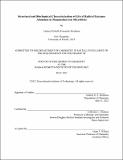Structural and Biochemical Characterization of Glycyl Radical Enzymes Abundant in Mammalian Gut Microbiota
Author(s)
Backman, Lindsey Richelle Fernandez
DownloadThesis PDF (39.54Mb)
Advisor
Drennan, Catherine L.
Terms of use
Metadata
Show full item recordAbstract
The glycyl radical enzyme (GRE) superfamily uses a post-translationally installed glycyl radical to catalyze difficult chemical transformations involved in a variety of anaerobic microbial pathways. In Chapter 1, I will provide an overview of the GRE superfamily and the fascinating reactions they are known to catalyze thus far. Although GREs are one of the most abundant enzyme families in the human gut microbiome, a majority of these enzymes still remain uncharacterized, however, limiting our understanding of how they function at the molecular level. To address this need, Chapters 2 and 3 of my dissertation focus on structurally and biochemically characterizing two newly identified gut microbial GREs, hydroxyproline dehydratase (HypD) and isethionate sulfite-lyase (IslA), from the pathogen and disease-associated bacteria, Clostridioides difficile and Bilophila wadsworthia, respectively. Overall, our work on HypD and IslA enabled us to propose enzymatic mechanisms for these new GREs; we can now take structure-based approaches to designing enzyme inhibitors that could lead to treatment of bacterial infections and associated diseases. Next in chapters 4 and 5 of my thesis I present structural, biophysical, and biochemical experiments that provided insight into the mechanism for how the most abundant GRE in the human gut microbiome, pyruvate formate-lyase (PFL), uses a spare part protein YfiD to restore activity upon oxygen damage in Escherichia coli. Lastly, in my concluding chapter, I provide my perspective on how we can use newly developed computational tools, such as AlphaFold and bioinformatic approaches, to prioritize and design targeted experiments to hopefully reveal exciting new discoveries about the GRE superfamily. Overall, my research on GREs and their associated proteins will not only add to the field’s knowledge of these critical metabolic enzymes, many of which could be antibiotic targets and have promising environmental and industrial applications, but will also expand our basic understanding of the biochemical reactions that govern bacterial-host interactions in gut microbiomes.
Date issued
2022-05Department
Massachusetts Institute of Technology. Department of ChemistryPublisher
Massachusetts Institute of Technology